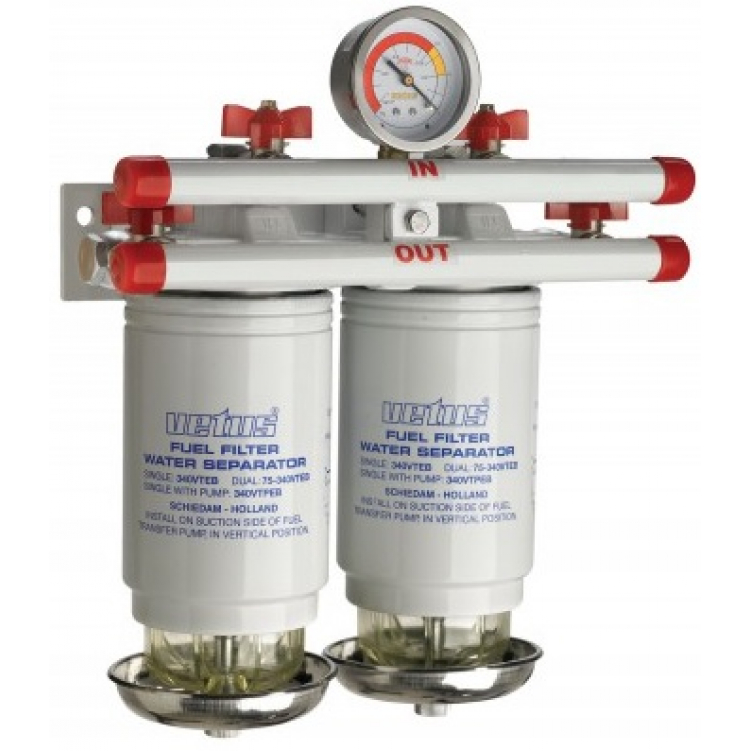A Fuel Water Separator is a critical component in many engine systems, particularly those using diesel fuel and in marine applications, where water contamination is a frequent threat. Its primary function is to remove water and particulate contaminants from the fuel before they reach the engine’s sensitive components, like the fuel injectors. By ensuring that only clean, pure fuel is delivered, the separator helps maintain engine efficiency, prevents costly damage from corrosion and abrasion, and prolongs the overall life of the engine.
🛠️ Components and The Science of Separation
A basic fuel water separator is typically housed in a metal or plastic canister and features several key components to achieve its goal:
- Filter Element: This is the core of the separator. It is often made of pleated material, such as cellulose, and is frequently treated with a hydrophobic substance. This special coating repels water while allowing the fuel to pass through.
- Collection Bowl/Sump: Located at the bottom of the canister, the collection bowl gathers the separated water. Since water is denser than fuel (diesel or gasoline), gravity causes the water droplets to sink out of the fuel and accumulate in this bowl. Some bowls are clear plastic for easy visual inspection, while others are metal with a drain valve.
- Drain Valve (Petcock): A small valve at the lowest point of the collection bowl allows for the periodic draining of the accumulated water and sludge.
- Centrifugal Stage (in some designs): High-flow separators, like those used on large diesel engines or marine systems, may incorporate a centrifugal fin design. This rapidly spins the incoming fuel, forcing larger water droplets and heavy particulates to the outer edges and down into the collection bowl before the fuel even reaches the filter media.
The separation process relies heavily on the physical principle that water is heavier than fuel and the fact that they do not mix. As the fuel flows into the separator, this density difference causes large water droplets to fall immediately to the sump. For smaller droplets, the specialized filter media causes them to coalesce, or merge together, into larger, heavier drops that then settle into the collection bowl.
💧 The Threat of Water Contamination
Water can enter a fuel system through several avenues, most commonly:
- Condensation: Changes in temperature, especially when a fuel tank cools down, cause humid air drawn into the tank to condense on the tank walls. This is particularly prevalent in diesel tanks.
- Contaminated Fuel: Water may be inadvertently introduced at the refueling pump, or during transport or storage of the fuel.
- Leaks: Faulty fuel caps, vents, or gaskets can allow moisture into the system.
The presence of “free water” (water that is not dissolved) in fuel can lead to severe engine problems:
- Corrosion and Rust: Water is highly corrosive to metal components, leading to rust inside the fuel pump, lines, and especially the high-precision fuel injectors.
- Microbial Growth: In diesel fuel, water accumulation creates an ideal breeding ground for microbes and bacteria, often referred to as “diesel bug.” This growth forms a slime that clogs filters and creates corrosive acids.
- Loss of Lubrication: Water displaces the lubricating coating of diesel fuel on high-pressure injector components, causing rapid wear, surface pitting, and failure.
- Freezing: In cold weather, water in the fuel lines or filter can freeze, blocking fuel flow and causing the engine to fail.
⚠️ Signs of a Problem and Essential Maintenance
A malfunctioning or saturated fuel water separator can lead to noticeable engine issues. Recognizing these signs is crucial for timely maintenance.
Common Warning Signs
- Engine Sputtering or Stalling: This is a key indicator that water is contaminating the fuel and disrupting the combustion process. It often occurs under load or acceleration.
- Dashboard Warning Light: Many modern vehicles are equipped with a sensor that triggers a “water-in-fuel” warning light when the collection bowl is full.
- Rough Idling or Power Loss: A restricted flow of clean fuel due to a clogged or full separator will cause the engine to run less efficiently.
- Visible Contamination: If the separator has a clear bowl, you may visually observe an excessive amount of water or the presence of microbial growth/slime.
- Unusual Noises: Gurgling or humming sounds from the fuel system can suggest the presence of water.
Crucial Maintenance Steps
Regular maintenance is the key to a functional fuel water separator.
- Drain the Water: The accumulated water in the collection bowl must be drained periodically via the petcock. Depending on the environment and use, this might be a weekly check or part of every service interval. Always drain until clean fuel begins to flow.
- Replace the Filter Element: The filter media will eventually become saturated with contaminants and must be replaced. Manufacturers provide a recommended service interval, typically based on hours of operation or mileage.
- Inspect for Leaks: Check the housing and fittings regularly for any signs of air or fuel leaks, which can disrupt the system’s function. Read more info
By performing this preventative maintenance, operators can ensure that the engine receives a constant supply of clean fuel, thereby protecting its longevity and optimizing performance.






